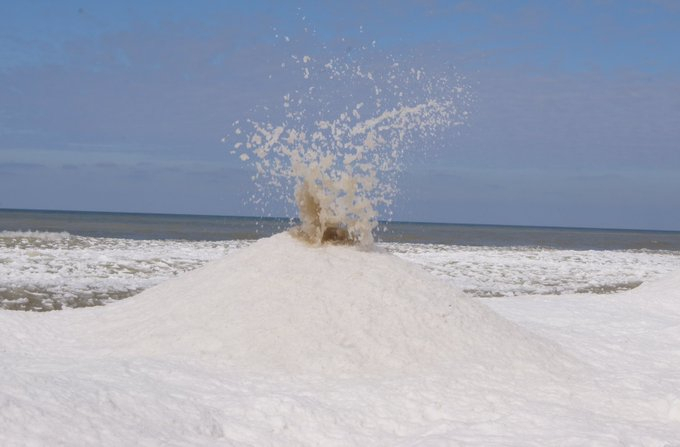While scientists said that the Tungurahua, an active ancient stratovolcano in Ecuador, is showing early signs of potential collapse, which could cause a massive landslide, last weekend Ice volcanoes spewed great plumes of water on the shores of Lake Michigan.
This weird phenomenon in Michigan was recorded by the National Weather Service (NWS). An employee of the NWS Grand Rapids took a few images of the event during a stroll on Oval Beach on the lake's eastern shore which is located in the state of Michigan.
The weird Ice volcano
NWS Grand Rapids employee who took the pictures of the unusual event, Tweeted that "You never know what you'll find at the lake until you go out there. Today it was volcanoes."
But there is a catch. Even though it is called Ice volcano, in reality, the cone-like mounds form at the edges of lakes are not volcanoes at all. Tom Niziol, a contributor for Weather Underground's Category 6 blog, explained in a Facebook post that from these mounds water shoots through holes in the ice. The water beneath the ice sheet and builds up enough pressure to force water to come out on the surface. If the air above is cold enough, then the released water freezes over the surrounding ground, which eventually helps to form a mini volcano of sorts.
Niziol said that "[Ice volcanoes] can be very dangerous to climb on however because they are hollow and built over that hole in the ice. Don't ever go venturing out onto them" and added that the frozen volcanos have formed along the shores of Lake Erie a few years ago but such events remain a relatively rare phenomenon.
The characteristics of an Ice volcano
Matt Benz, a meteorologist for AccuWeather, said in a report that "It's almost a 'Goldilocks' situation where you need just the right conditions over a period of time to get these [formations] to develop."
It should be mentioned that these volcanoes usually form near large bodies of water where below-freezing temperatures allow an ice shelf to form over the water's surface along the coastline. Meanwhile, the powerful water beneath the shelf crack the ice and push water out.
When the Oval Beach volcanoes were noticed on February 16, the wind was almost due west, which was probably an ideal situation for pushing waves right into the shoreline at this location, said Benz. He also added that due to the enormous size, the Great Lakes may be more likely to form ice volcanoes along their shores than smaller lakes where the water completely freezes over in winter, before the creation of the ice along their beaches.










